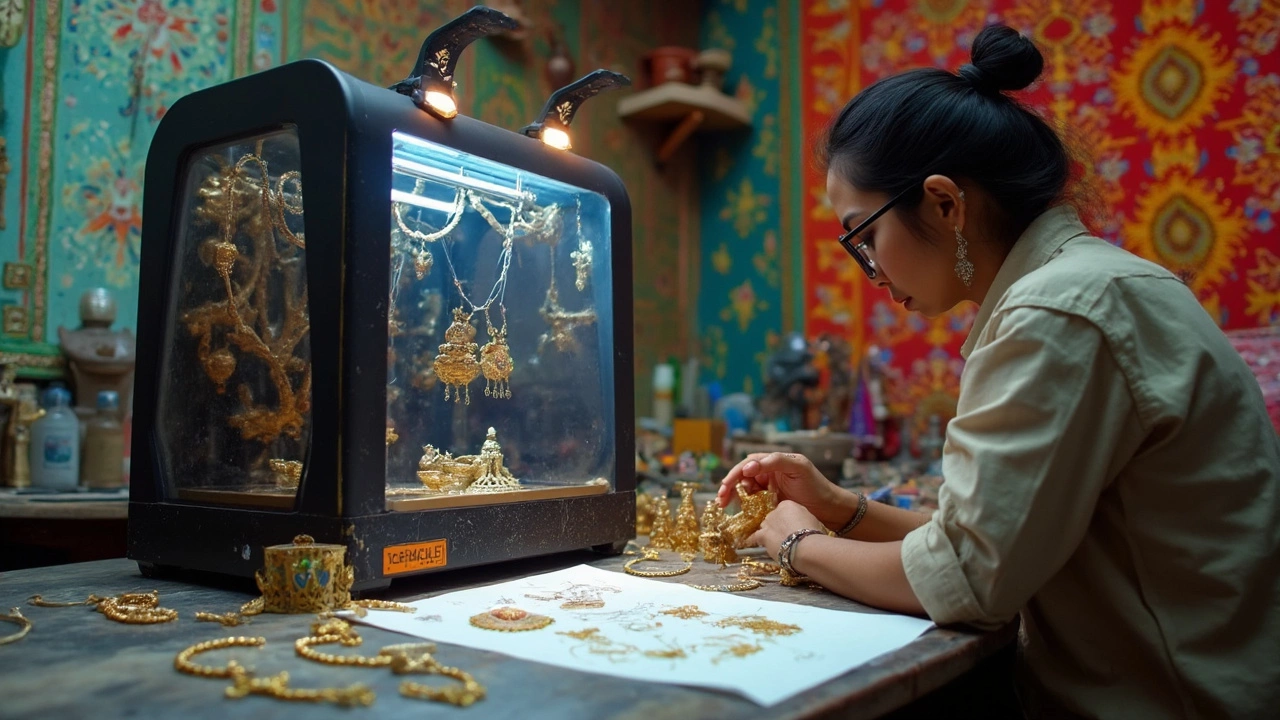3D printing has revolutionized many industries, and jewelry making is no exception. But when it comes to using metals, there's a catch—not all of them play nice with a 3D printer. Curious why your favorite metal might be a problem?
To kick things off, let's consider what happens during 3D printing. It involves layering materials to build an object, and with metals, this process can get tricky. Metals like lead and tin, for example, have melting points that either don't jive with the printing process or result in weak, unusable parts.
Then, there are the precious metals like platinum or pure gold. While they can technically be printed, the cost and effort make it impractical for your everyday jewelry creation. Imagine printing a ring that ends up costing more than a small car! So, what's a jewelry enthusiast to do?
Understanding these reasons helps avoid costly mistakes and ensures that your next project glitters as intended. Stick around as we delve deeper into the metals you should steer clear of and uncover the tips to pick the perfect ones instead.
- Understanding 3D Printing and Metals
- Metals That Pose Challenges
- Why Some Metals Can't Be Printed
- Tips for Selecting Metals in Jewelry Making
Understanding 3D Printing and Metals
3D printing, also known as additive manufacturing, has transformed how we create stuff—from toys to complex machine parts. The magic happens by layering materials, building up the object, bit by bit. It's efficient, flexible, and opens doors for customization like never before.
When it comes to metals, things get a bit more interesting. Metals aren’t just melted and poured into a mold. Instead, they are usually printed using powder or wire forms, which are then solidified by heat from a laser or electron beam. This is more complex than it sounds and has unique challenges.
Why Are Some Metals Compatible With 3D Printing?
Some metals, like titanium and stainless steel, have naturally strong properties and can withstand the layers building up without collapsing or warping. They also have a melting point that works well with the techniques used. That’s why you see a lot of 3D printing metals in the aerospace and medical industries where strong, precise parts are essential.
Challenges with Certain Metals
However, not all metals are a good match. Soft metals like tin can deform too easily under heat. Precious metals, often used in jewelry making, pose economic and technical challenges. They either don’t respond well to the printing process or cost more due to their rarity and the meticulous work required.
If you’re thinking about experimenting with 3D printing in jewelry, understanding these basics can save you both time and money. Don’t let the excitement of the technology sway you before you know the fundamentals!
Metals That Pose Challenges
Not every metal is ready to take the leap into the 3D printing world, especially when it comes to jewelry making. Let's get down to the nuts and bolts and talk about some common metals that just aren't up to the task.
Trouble With Lead and Tin
First up, we've got lead and tin. These metals are notorious for having low melting points, which might seem like a good thing at first. But in 3D printing, it's a recipe for disaster, as they can solidify unevenly and create weak spots in your designs. Aside from potential structural issues, there's a health concern: lead is toxic, and so handling it needs extra precautions.
"Lead's low melting point and toxicity make it unsuitable for most standard 3D printing processes, especially for objects that require durability." - an industry expert, TechMetal Journal.
Precious Metals: Platinum and Gold
Platinum and pure gold fall into a different dilemma. While theoretically possible to print, the costs and complexity make it impractical for regular crafts. These metals require specialized equipment and substantial energy to reach the high temperatures needed to print.
Stainless Steel's Steely Competitor
Stainless steel sometimes behaves unpredictably due to its own set of challenges. Specifically, the inherent density and specialized heat treatments it requires can complicate the 3D printing process. This can often lead to warping or unwanted stress within a piece.
- Lead: Low melting point and toxicity make it unsuitable.
- Tin: Similar issues with temperature and brittle structure.
- Platinum: Technically possible but costly and energy-intensive.
- Pure Gold: High cost makes it impractical for most projects.
- Stainless Steel: Complex heat treatment and risks of material stress.
So, if you're venturing into 3D printing for your jewelry making endeavors, it helps to know which metals to approach with caution. Weighing the difficulty and risk against potential benefits is key in making a smart choice.

Why Some Metals Can't Be Printed
So, why are some metals out of reach for your 3D printer? It's all about the science. Different metals have unique properties, and some just don't mesh well with the 3D printing process.
Melting Point and Temperature Control
One of the biggest hurdles is the melting point. Metals like lead and tin melt at relatively low temperatures, and while that might sound like an advantage, it really isn't. Low melting point metals could vaporize or not solidify correctly when layered, leading to a weak structure. Then you've got metals that need extreme heat, like titanium, which require specialized equipment that most hobbyists can't access.
Cost and Economics
Even if you can print with these high-temperature metals, the cost might be prohibitive. Take precious metals—sure, you can print with platinum or gold, but the expense often outweighs any potential benefits. Imagine crafting a ring with these metals only to see the cost rival a down payment on a house!
Material Properties
Let's not forget about the innate nature of these materials. Some metals can be chemically reactive, which poses safety risks during the printing process. Others can have a high thermal expansion coefficient that causes distortion as the metal cools.
- Lead: Low melting point, safety concerns due to toxicity.
- Tin: Soft, can distort easily.
- Gold: High cost, sophisticated equipment needed.
- Platinum: Economic impracticality for most projects.
Alternatives and Solutions
But don’t worry, there are alternatives. Instead of directly printing with some of these tricky metals, you can use more manageable materials like steel or wax and then apply traditional techniques like lost-wax casting to achieve the look and feel of more complex metals in your jewelry making projects.
Knowing these limitations helps you make smarter, more cost-effective choices. Whether you're a hobbyist or a pro, understanding which metals play well with technology could save you a lot of headaches—and dollars—down the line!
Tips for Selecting Metals in Jewelry Making
When diving into the world of jewelry making, choosing the right metals can make or break your creations. It's all about knowing what works and why. Ever wondered which metal might give you a headache and which will be a piece of cake when it comes to 3D printing? You're in the right place.
Consider the Metal’s Properties
First up, think about the properties of the metal. Metals such as aluminum and titanium are popular choices. Why? They're strong, lightweight, and compatible with many 3D printing setups. So, if you're about to start a jewelry line, these might be your go-to gems.
Melting Points Matter
The melting point of a metal is crucial. If it melts too easily or not at all under the 3D printer's capabilities, it's a no-go. Select metals that fit well with the heat specifications of the printer. Remember, simple doesn’t always mean lower quality.
Cost-Effectiveness
Nobody wants their new necklace to cost a fortune in materials alone. Opt for metals that provide a good balance of aesthetic appeal and affordability. Stainless steel is a great example, as it's durable and doesn’t break the bank.
Finish and Detail
Lastly, don't forget about the finish and detail you want. Some metals take to intricate designs better than others. For highly detailed pieces, fine silver or brass can offer a brilliant sheen, making your jewelry standout.
Chart of Metal Suitability
Here's a quick snapshot of some metals and their basic suitability for jewelry making:
| Metal | Compatibility | Cost | Durability |
|---|---|---|---|
| Aluminum | High | $$ | High |
| Titanium | High | $$$ | Very High |
| Stainless Steel | Moderate | $ | Moderate |
| Brass | High | $$ | Moderate |
Selecting the right metal might seem like a lot to chew, but it's your ticket to crafting beautiful, compelling jewelry pieces without the hassle. Trust your gut, and go with what suits your project best.



